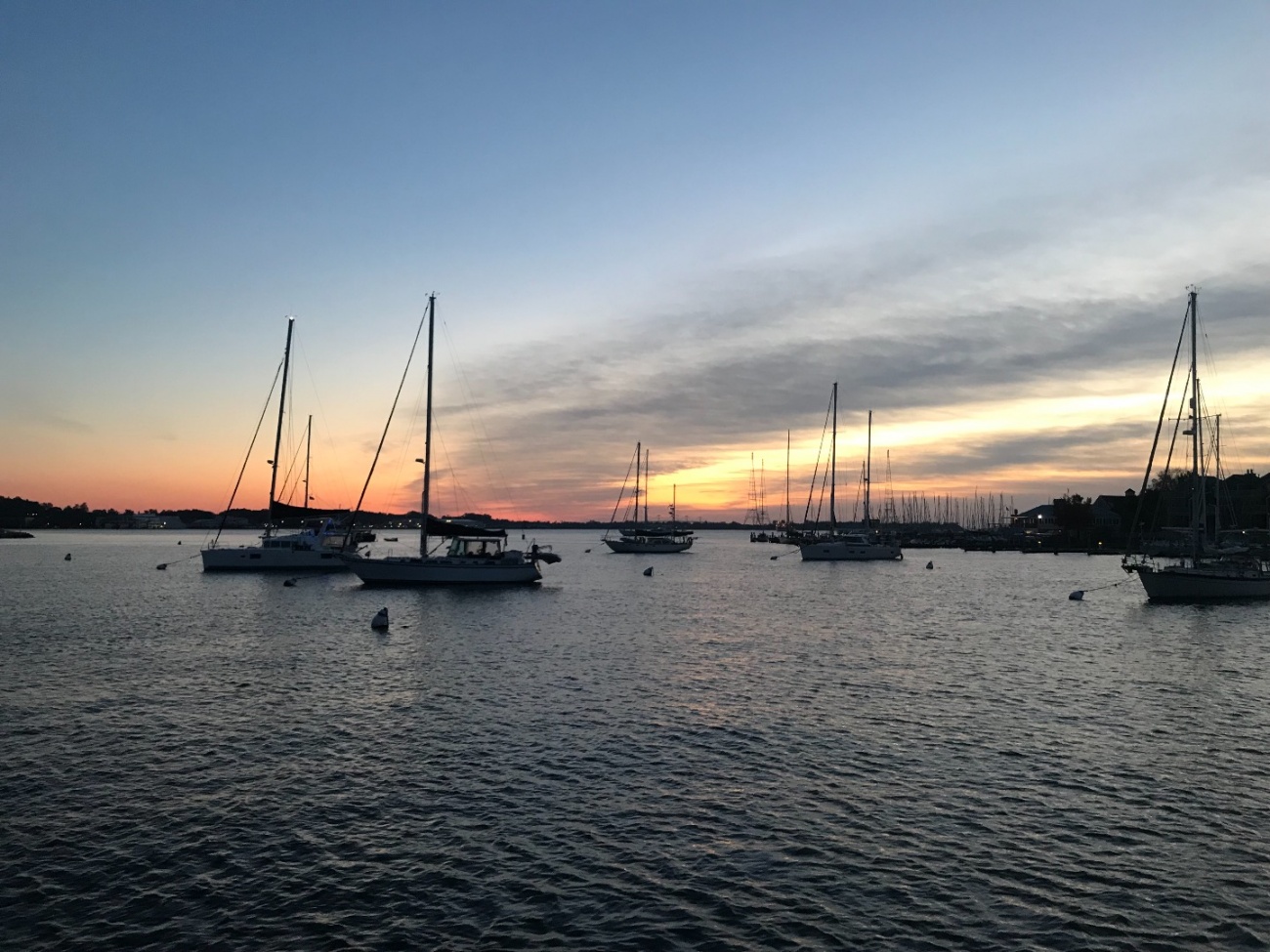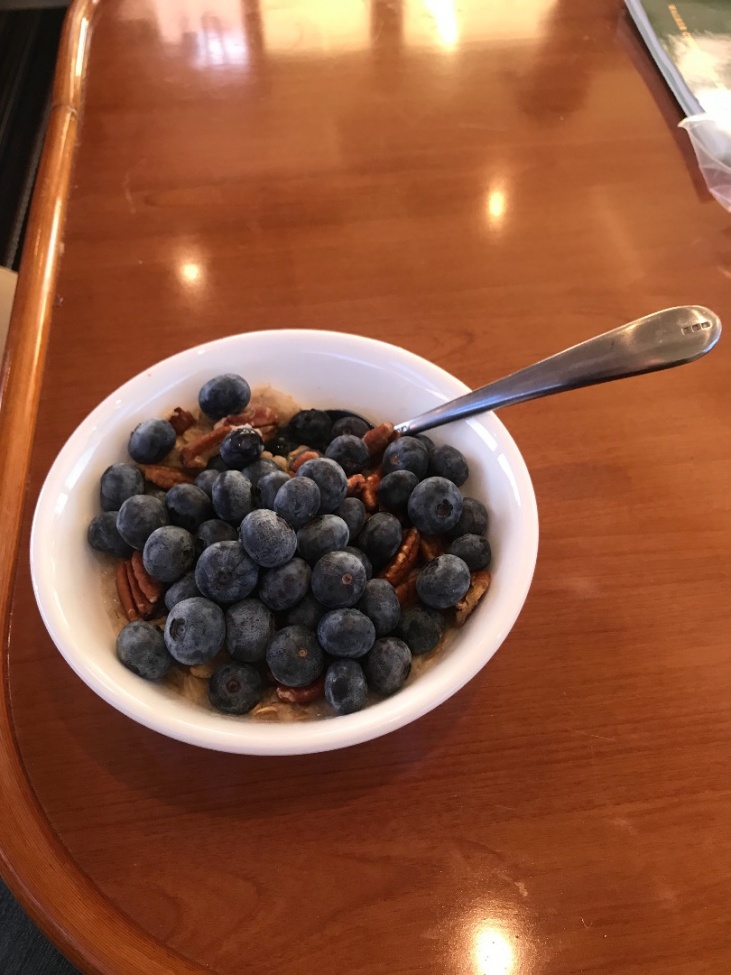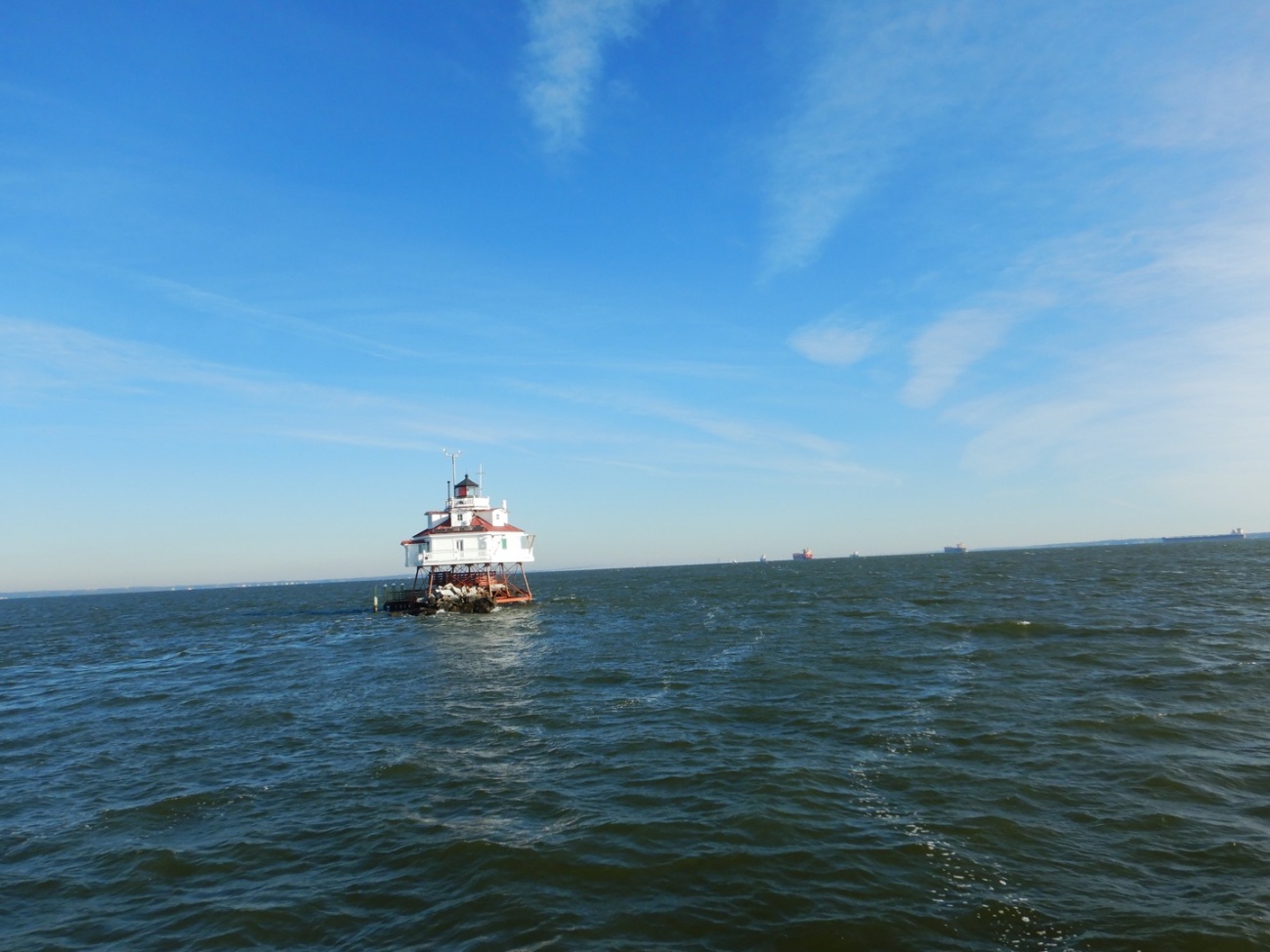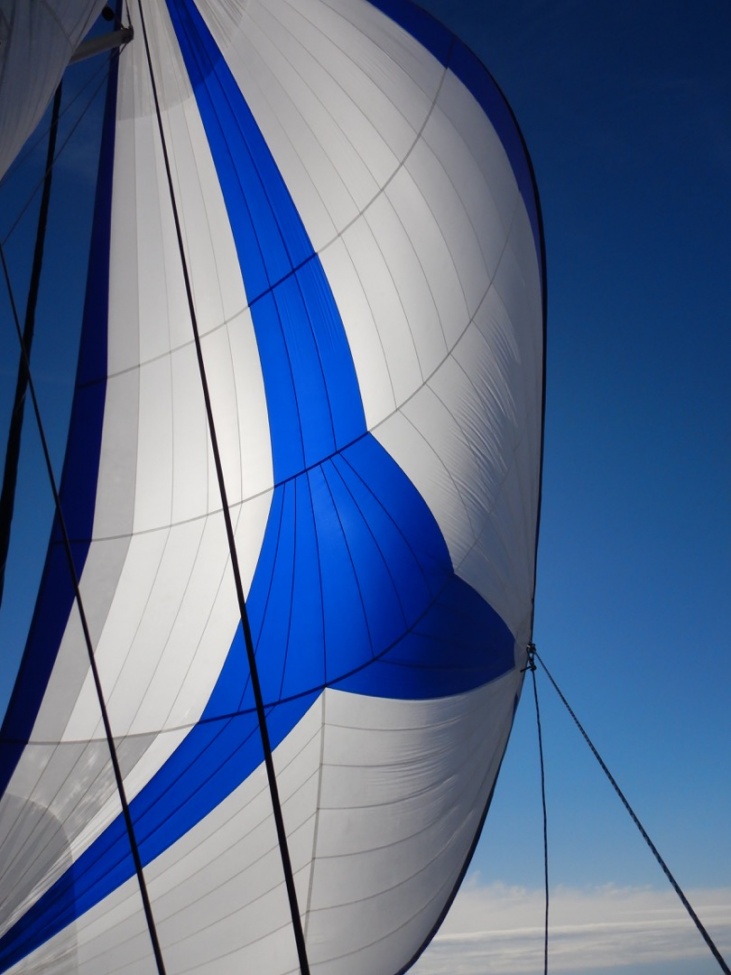Sailing Adventure Aboard AraVilla (No Motorcycles Involved)
'Wednesday November 3rd, 2021 7:30'
This adventure is over.
I was so tired last night I started falling asleep as I was trying to write. I had not slept that well the night before.
In contrast to the previous morning, today I woke up of my own accord before 7:30 which was the agreed upon time that Dana should wake me up if I overslept my alarm. I suspect my subconscious understood that the sound of the generator being fired up meant "coffee". I was awake, dressed, and in the salon in short order. As my subconscious had divined, there was, in fact, coffee freshly made.
I went out to witness this thing called "Mourning".
It was quite cold but very pretty. The genset was running so I was able to make myself some oatmeal and have a quick breakfast before grabbing a shower. I am not starving here.
The central heat pumps, of which there are three, seem to all be low on freon as they don't generate much heat from this cold water, but they certainly should generate some. So we have a few ceramic space heaters that keep things comfortable except in the bathrooms. After a quick breakfast, I took a shower with nice hot water. You can't run them for long because the basin fills up so it's done in stages between which you turn the water off.
That's when one really noticed the cold.
Getting out of the shower was even colder.
Thankfully the salon was quite warm as the space heater was blasting. A few minutes in front of it and I was good to go.
By 8:30 we were underway motoring our way to the mouth of the Severn River to the Chesapeake Bay.
Since there was good light wind coming down the Bay, Dana wanted to fly the spinnaker. The spinnaker is a sail that's most often deployed when the wind is pretty much right behind you pushing on the rear, or stern, of the boat. Looking at the curvature of the Bay and where we wanted to end up along with the wind direction I figured we should head out pretty far across before raising the sails.
I had wanted to show the two of them Thomas Point Lighthouse which is one of those iconic Maryland symbols you see on all the post cards, but we were moving along and I didn't want to interrupt when Dana suggested we turn to go past it for some photos prior to raising the sails.
Dana mentioned it was about time to raise the mainsail. Out of the corner of my eye, I noticed he was walking towards the helm. Suddenly I saw he had a life ring in his hand and he threw it hard overboard to starboard (to the right side as you're facing the front, or bow, of the boat) and shouted "Man Overboard!"
I had asked him a few times whether we could do a man overboard exercise. I didn't suspect we would do it as a surprise without having practiced it first as a non-surprise.
I had listened intently when Dana had instructed me on what to do.
I immediately hit the man overboard marker on the chart plotter which marks the spot where the crew person went over. Peter threw a life ring to the pretend man overboard.
Then I went to turn the wheel but it wouldn't turn.
The auto-helm was on and looking at the cover of it I didn't, at this time, know how to get it to release control. Dana pressed the STBY button for me. I was frantically looking for "Off". I turned the wheel hard to starboard, slowed the engines, and made my way next to the life ring in the water but at first didn't get it quite close enough for Dana to reach with the pole on the first try. With a little maneuvering with the engines being careful to be well away of the pretend man overboard as to not risk an injury with the propellors, I got the vessel close enough to the ring for Dana to pull it in. The time estimate was a total of 2 minutes. I had watched a youtube video that suggested moving to the side of the man overboard down wind. Dana suggested it would be easier if I had been upwind since the wind would have pushed us towards the man overboard.
I was glad to have this practice. I asked about what to do under sail, and it was suggested just to fire up the motors and immediately turn towards the man overboard especially in the cold waters we'll be in initially.
Not long after, Dana raised the mainsail and as there was a good breeze I turned off the engines. My thought was that I should gain as much experience with how the boat feels under sail in waters I am intimately familiar with before we head Out There(tm). Anyways, this is a sail boat. It should be sailed is my thinking.
The change in feel of the boat when it goes from propelled by engines to propelled by sails, especially in wind that seemed to change direction randomly from time to time, was striking. Under diesel power, one can essentially point the boat in the direction one wants to go and that's most of what there is to it. Under sail, as the wind and waves push the boat around I find I needed to be much more active with the wheel. After some time of trial, overcorrection, and error trying my best to pay attention, I noticed that when gusts of wind came or the wind changed direction, I could feel it in the wheel. The wheel would push and pull or go slack as the boat moved through the water and the wind changed. A change in wind direction changed the feel in one way. A change in wind speed changed the feel in another. Waves produced yet a different feel.
Once we had travelled far enough out into the bay, Dana decided the wind was good and that it was time to fly the spinnaker. Dana loves flying the spinnaker. He talks about flying a spinnaker the way people who have deeply meaningful religious experiences talk about them. However, flying a spinnaker adds a whole new level of complexity to a novice behind the wheel.
I know how to pilot a boat and honestly if things are going well, I can probably do a passably decent job of getting us where ever we need to go under sail. But what I do not have is a good sense of the kinds of things that can go wrong or how to respond when they do. My suspicion is that when things go wrong senses get overwhelmed, lots of stuff happens, and one has to have things practiced down a degree where they are muscle memory, the way I do on a bike.
At this point, I pretty much simply don't have this muscle memory or understanding of what can go wrong or what it look like. As a result many of my questions have been about what to do when things go wrong.
My favorite saying in German is, "Wenn schon denn schon." which essentially means if you're going to go then go all the way. Do it thoroughly and properly. It can also be used as a joke to comment on throwing someone into the deep end.
I was at the wheel, as would be the case for the majority of the day, while Dana and Peter wrestled the spinnaker into place. The wind had been picking up a bit and after some initial fiddling the spinnaker puffed out and took shape but it wasn't quite right and there were some adjustments that had to be made.
The wind picked up a bit more and we started to pick up speed. I noticed that the boat once again felt differently when compared to how it felt just under the mainsail or on engines. It was like the front was getting pulled this way and that. Dana and Peter worked on adjusting the sail when a large gust of wind came and there was a pop and before I could comprehend what had happened the spinnaker was flapping around in the breeze dramatically to starboard and I did not know what to do. The noise of the spinnaker flapping around made it exceptionally difficult to understand Dana's commands.
Some thing had failed, a shackle?, which released the spinnaker. Senses overwhelmed, trying my best to understand what was being said over the cacophony from this flapping dragon of a sail, I fired up the engines and turned the boat into the wind. Peter tried to hold the sail as it came around the boat. Under instruction, I turned on the auto-helm and went to help Peter but we couldn't hold it, so we let it go and into the water it went.
I went back to the helm, turned off the auto-helm, and kept the boat pointed into the wind, mainsail luffing disturbingly, while Dana and Peter pulled the soggy spinnaker in and stuffed it wet into the bag.
"We're going to have to find a way to dry that because it'll mold up if we don't." Dana said.
Undaunted by this mishap, after a short rest, Dana retrieved a replacement part and soon he and Peter were back at setting up the spinnaker.
I do not understand where he finds the energy.
The second attempt was completely successful and soon we were sailing almost completely down wind with the spinnaker up as if nothing at all had happened but now I have first hand experience of one thing that can go wrong and some sense of how to respond with a bit more clarity.
The spinnaker is the blue and white sail.
A spinnaker flapping in the wind is properly unnerving.
Experience is directly proportional to mistakes made and equipment ruined.
I have pondered this journey and my relative lack of experience. From a motorcycling perspective, when riders tell me they want to go on some big trip, maybe the Trans America Trail, I have endless advice on things to prepare for, skills to develop, and other ways to stay Safe(tm). I think of all the problems I've run into during my travels that I somehow want to save people from.
Yet, my first cross country trip was almost entirely by the seat of my pants, relatively speaking, especially compared to what I know now. I did that first 13,000 mile trip in 1991 with no instruction other than the MSF safety course. I didn't have anyone to mentor me. I had no guide. I just went while trying my best to imagine the kinds of things I might encounter or problems I might face, with only paper maps and absolutely no way to communicate with anyone while I was Out There(tm). I wonder how that risk compares with this risk. I actually have many more years behind the wheel of a boat than I had on a motorcycle when I left in 1991. I had only been street riding since the age of 17 and in 91 I was 23.
I look at my InReach satellite messenger with its SOS button. I look at the brand new EPIRB (emergency locator beacon) mounted prominently at the entrance to the salon.
Is this an unacceptable risk? It certainly sounds scary. Hundreds of miles off shore in a 46 foot sailboat. But we have satellite weather, a forecasting/routing service that provides us with go/no-go dates and suggested routes for the smoothest sailing. We have a 12 man off-shore rated life raft with days of provisions. We have a boat that is very difficult to sink. We are all capable, intelligent, serious people.
Is this trip more risky than my 13,000 mile trip, two thirds of which I did solo, in 1991?
These are the questions I ponder. Regardless of the answer, I know I am going.
"If I get you killed my sister (Brooklyn's mom) will kill me." Dana said.
"If I get you killed, she'll kill me, so I think we both have a vested interest in the others survival." I replied
"Peter we're not so sure about." Dana replied.
"That's why you have a third crew member, a spare." Peter replied.
Were there any signs, any signs at all, you know, in the beginning ...
We spent the remainder of the day sailing with the spinnaker up with me at the helm with the exception of one small break.
Inattentiveness or steering errors would cause this big puffy sail to collapse and start flapping all over the place disturbingly. I quickly learned to be hyper-vigilant and soon determined what kinds of maneuvers would cause it to "lose shape" as they say.
The observation I had made about the wheel when powered by the mainsail was much more pronounced with the spinnaker up. Your tactile and auditory senses provide so much information. After a while you could just feel what the boat was doing through your feet, through the wheel, and the sound of the sails.
There's a youtube channel I've been following for a while now by a guy named Adam Chan. His channel is called The Kung Fu Report and he teaches the Wing Chun style of Kung-fu. While I find Wing Chun intellectually interesting, I'm not sure I want to practice a martial art at this age, but what has drawn me in is that he is a deeply philosophical, insightful, and incredibly well rounded in his perspectives and what he draws upon. Martial Arts, Taoism, Chinese philosophy, Western Philosophy, Psychology, Mythology, Physiology, Biomechanics, Evolutionary psychology, Medical research, and the list goes on. He is a truly impressive multi-discipline philosopher warrior.
One thing he talks about with regard to martial arts is developing a tactile sense, a feel, to respond to some stimuli or threat. If you are thinking you'll be too slow. It turns out in Wing Chun and other styles, there are tactile feedback exercises they perform to develop a feel of what their opponent is doing as they block and how to respond and to develop it to such a degree that one doesn't have to think about it. He demonstrates being able to hold a conversation while someone is trying to break his guard. It's impressive. But it's also what I do on a motorcycle. I've heard so many people talk about the checklists and hypervigilane, but that's not how I ride. I let my mind relax and I ride by feel because I've been doing it for so long.
From this I came up with a saying I've been pondering for a while now, "Thinking is slow. Feeling is fast." We call it muscle memory but it's more than that.
"Use the force, Luke"
With this in mind, I spent a good amount of time focusing on the feel of the wheel, the boat beneath my feet, and the sounds i could hear. The more I did this the easier it became to will the boat roughly in the direction I wanted it to go. While it is incredibly energy and activity intensive, there's something to this sailing thing. Peter and I were talking about it. He doesn't have much interest in learning how to sail while I do. "Why do you want to learn how to sail? Are you going to buy a boat?"
"No." I replied. "I just want to get invited back onto this one."
We made good time. The winds picked up and at one point for a short moment we were clipping along at 10.9 knots.
"If you reach 11, I'll guy you a scotch." Dana said, but alas I was unable to get that last .1 out. That would be the fastest we went.
We approached the Patuxent River while the winds were getting to what Dana said the spinnaker could handle. The problem was the winds were too high to reasonably, with this crew, drop the thing. So we continued on while a large container ship made its way past us. It was a bit challenging to manage the sail, our direction, and the wind. Shortly after the ship went by the wind died down and we took the opportunity to lower the spinnaker. Then we lowered the mainsail and motored into Solomon's Island.
We found a transient dock and Dana asked, "Do you have this?"
"No problem." I replied not pondering the fact that I had never docked this boat before. There was virtually no issue. We were secured and resting easy before we knew it.
I pondered crews. I can't remember a time when I've done anything even a fraction of this magnitude with people I haven't been in close contact for years. Sure, I've known Dana for 7 or so years now, but we haven't spent a huge amount of time together over those years, but we have certainly been through exceedingly difficult times together. Peter I just met. The three of us have never done anything together as a team. We're just thrown together and somehow it's working quite well. I am beginning to understand why there are so many specific terms for things and directions and why there is a sailing culture that dates back ages. Crews need to be able to work together, to cooperate and communicate effectively, to get the ship going where it needs to go. Along the way, when Things(tm) happen there needs to be a shared culture, a shared understanding, and a shared vision of what and how things need to be done.
Hmmmmm.
The few errors were largely ones of communication, noise, and a lack of shared experience. But that is slowly changing. This time on the bay gives us a chance to meld a bit. It's already much easier.
I am not as good at remembering direct quotes anymore. It troubles me, because I hate paraphrasing. "This is amazing. The things I get to see here on this trip, few get to see. I've been reading about these places, Baltimore, Annapolis, Solomon's Island for years and now I'm here. Few people get to do this." Peter said.
"I agree. " I replied.
On a completely separate note, it's been interesting to see how this platform I've built applies so well to sailing trips. There is so much overlap between how long distance riders ride and how long distance sailor sail. I uploaded a bunch of photos to the Photos tab, as has Dana, who just started using the site. Peter is on the site now as well.
It's pointed out a lot of problems and places where I need to make improvements. If you're interested in following along on this journey of ours you can click Join up at the top of the page and signup for an account on the site and then click WATCH on the ride. I've updated the Trip Map with the track from the Garmin InReach to show where we've been and with a bunch of geotagged photos. I'll keep that up as we have connectivity.
To make it easier to find your way back here, in case you are interested, you might want to bookmark this link:
Sailing Adventure (No Motorcycles Involved)
I've been invited to crew on a 47' catamaran sailboat leaving from Annapolis, Maryland to St Martin. I am tempted to stand up another site just for this trip, so as to not dilute Miles By Motorcycle, but I am stretched pretty thin these days so I don't know if I'll get that done before I leave. I just find having a place where I can keep all the things around a trip in one place is just too useful, so this "ride" is where I am planning and will document my upcoming sailing adventure. Feel free to join the site and "watch" this "ride" to get notifications when I post updates. There will be a number of days when I won't have any signal so updates will be intermittent.
https://miles-by-motorcycle.com/yer...
And then notice across the top the Blog, Plan, Posts, Trip Map, and Photos tabs.
On the two maps you can zoom in and click on things. If you're on a phone and you want to click on some point of interest, move the map a bit so that the thing you're clicking on is not in the upper left corner because there's a bug.
I took a bunch of video today and tried to upload it to Youtube but the connection here is very slow, so that will have to wait
The plan is to go to Tangier Island tomorrow which is only about a 40 miles sail from here, then we'll head to Norfolk the next day. The consensus was that we don't want to sail into Norfolk in the dark. Besides, I've always wanted to see Tangier Island and we have the time because of that storm. That's a topic for another day.
I'll keep posting as I have time and connectivity. There'll be a multi-day gap as we venture Out There onto the Atlantic and down to St. Martin.







You must be a member of this group to post comments.
Please see the top of the page to join.